2018 CHE Place-Based Workshop
Places Visited
Day 1 – Opening Panel and the International Crane Foundation
In-Between
By Noemi Quagliati (LMU Munich)
A white-naped crane stares out from behind a pen made of iron and Plexiglas. It is one of the fifteen endangered crane species protected by the International Crane Foundation in Baraboo. Although the close-up emphasizes the visitor’s proximity to the animal, the visual obstacle of the fence also reminds the viewer of the ongoing collision between human and nonhuman beings. This photo makes me think of Rilke’s poem The Panther.
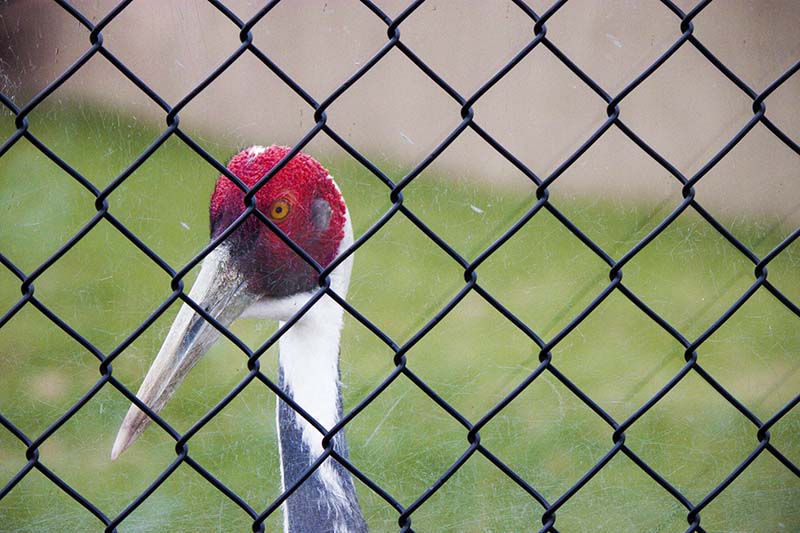
In the Jardin des Plantes, Paris
From seeing the bars, his seeing is so exhausted
that it no longer holds anything anymore.
To him the world is bars, a hundred thousand
bars, and behind the bars, nothing.
The lithe swinging of that rhythmical easy stride
which circles down to the tiniest hub
is like a dance of energy around a point
in which a great will stands stunned and numb.
Only at times the curtains of the pupil rise
without a sound … then a shape enters,
slips though the tightened silence of the shoulders,
reaches the heart, and dies.
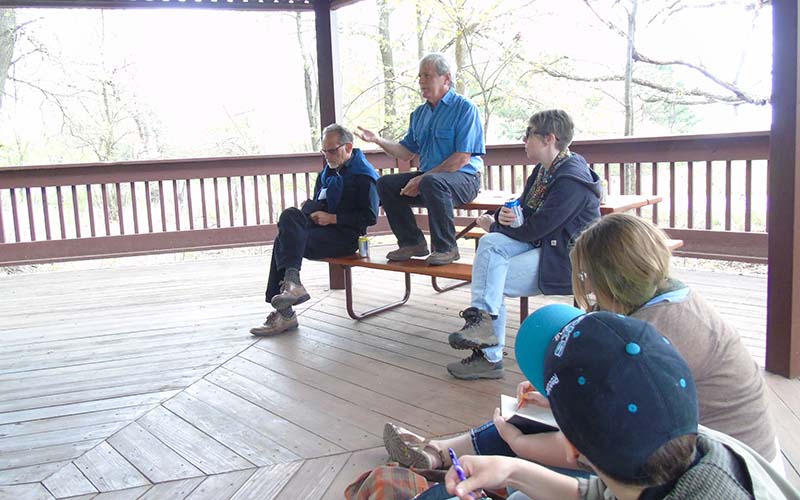
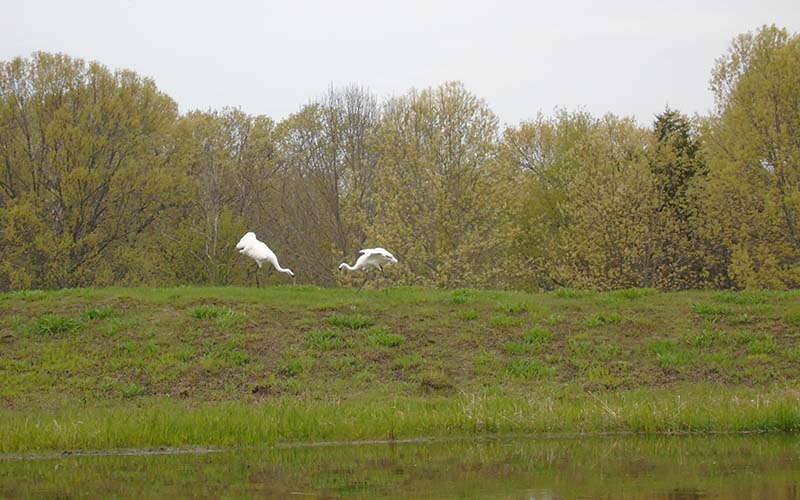
Photos courtesy of Nicole Fischer
Lie Back and Think of Whooping Cranes
By Eline Tabak (LMU Munich)
As somebody who has dedicated the last 6 (almost 7) years of their life on stories, I spent a lot of time during the place-based workshop thinking about story-telling and the differences between individual and collective story-telling. This focus on story-telling gained sharper focus when we visited the International Crane Foundation in Baraboo, and we walked through the park with two guides, both young women.
While looking at the dancing whooping cranes (an incredible experience in itself), I first heard the story of Dr. George Archibald (co-founder) and the human-bonded whooping crane Tex. This was very much a story of an individual, and not a species. Tex, being human-bonded, would not mate with other whooping cranes, her own species. A problem when you’re trying to save this particular species from extinction.
One the guides told us how Dr. Archibald wooed Tex and was able to artificially impregnate her when she “assumed the position.” Lie back and think of whooping cranes? We all laughed, but I keep thinking: was it really funny or was it uncomfortable? I remember feeling uncomfortable, but not really being able to articulate (or even thinking about articulating) why. It was only in the bus on the way back to Madison that one of the workshop organizers and participants was able to put this into words.
Day 2 – Henry’s Honey Farm and Poupart Fish Hatchery
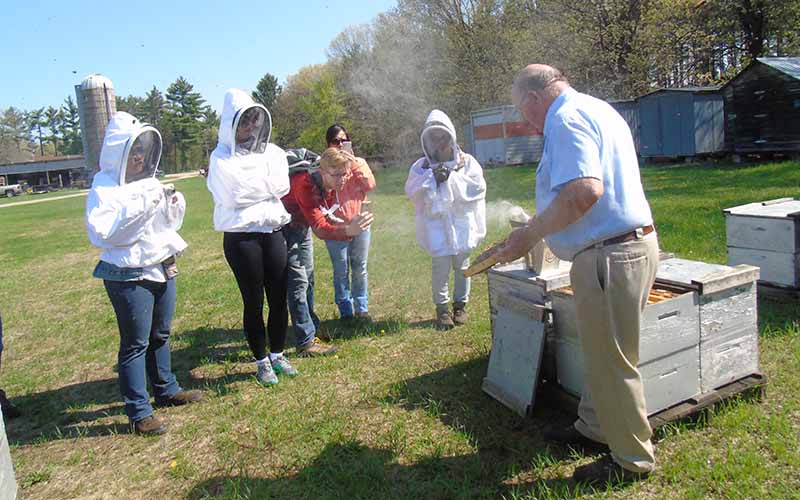
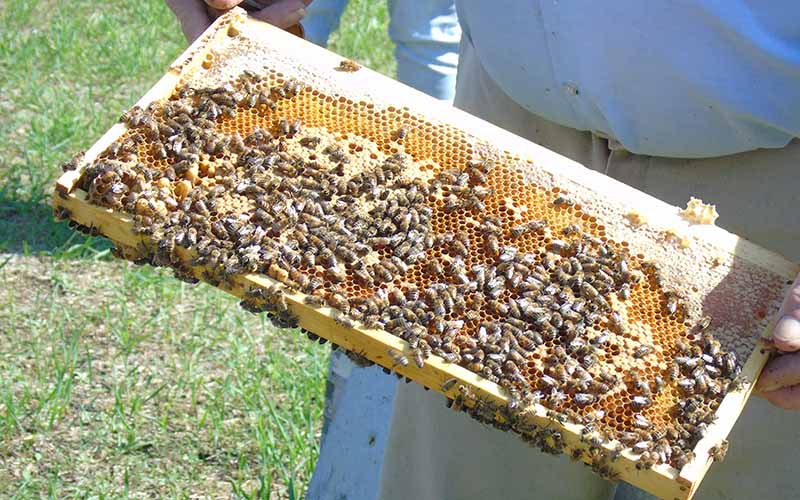
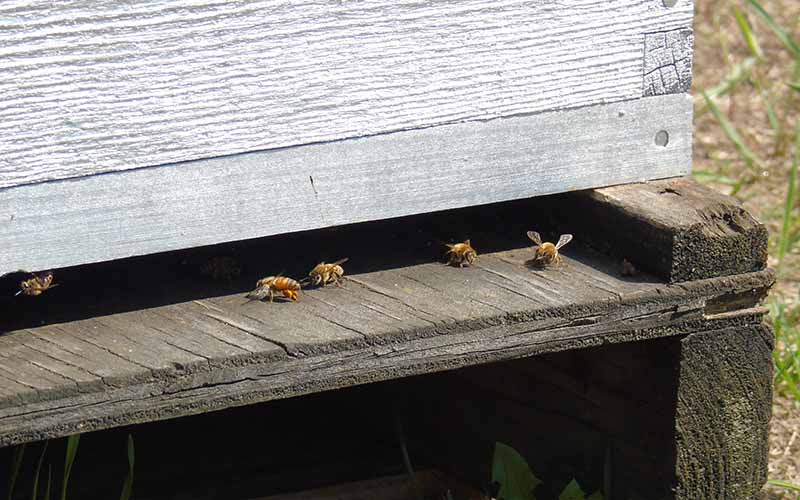
Photos courtesy of Nicole Fischer
Mind the Bees Please!
By Jessica Montez (UW-Madison)
What struck me about the Place-Based Workshop, “Animating the Landscape,” in 2018 was how immersive the whole experience was. It was my first CHE PBW, so I was hesitant of my expectations. Surprisingly, it transported me to a grade school field trips where you experience the world outside the classroom and students are encouraged to use all five senses. Except, as adults, it wasn’t simply a transient experience, because the learning experiences were more solidified and imbedded, given our years of education and purpose for being there.
Though there were many memorable stops and topics, the visit to Henry’s Honey Farm and apiary was transformative for me. We had to be cognizant of not only our movements, but our emotions as well. The immersion was us becoming part of the bee’s landscape, with every movement steady and each breath intentional. A memorable moment was classmates donning beekeeper suits for the full experience, while others watched from afar.
For me, the workshop (and seminar) collectively elucidated environmental humanities through visual and immersion learning. Prior to visiting the apiary, I had only read and heard discussions on the fate of bees, but immersion onto a bee’s habitat gave me better appreciation of their presence and purpose in this shared space.
Day 3 – Tribal Management and Wildlife Discussion and Elk Reintroduction and Habitat Restoration
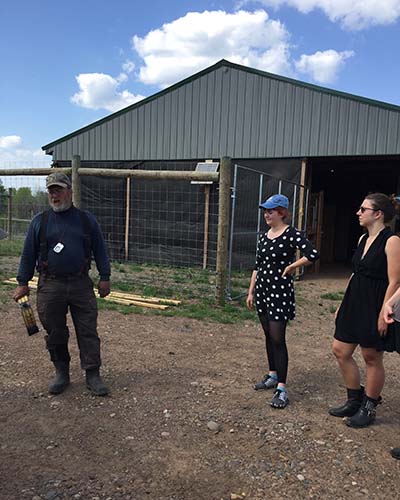
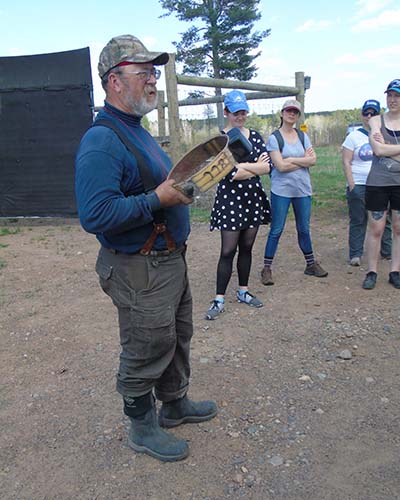
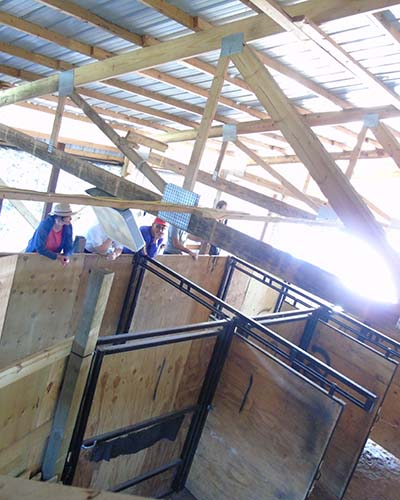
Photos courtesy of Lynn Keller and Nicole Fischer
Day 4 – Raptor Education Group and Van der Geest Dairy
What Does it Mean to Hunt? A Stalking Trip through Wisconsin
By Laura Kuen (LMU Munick)
More than eleven million people regularly hunt in the United States (U.S. Fish and Wildlife Service 2016:24) and Wisconsin is an especially popular hunting ground. Therefore, it is no surprise that the trope of the hunt and hunter kept crossing our way during the Placed-Based Workshop of the Nelson Institute for Environmental Studies in May 2018. Starting in Madison and traveling through the entire state of Wisconsin, the workshop thematically focused on points of contact and collision between human and nonhuman lives. The lives we encountered, often intersected along the trajectory of arrows, shot and bullets.
In fact, the traveling character of the workshop made us see and understand how diverse and hotly debated the topic of hunting is. Making use of the fleeing perspective of a traveler, I hope to draw a worthwhile and complexity-revealing sketch that takes as many stakeholders into account as possible.
First – The Hunter
Reasons to hunt seem to be plenty. According to the hunting guidebook of the Aldo Leopold foundation, motivations for people to become hunters include improving knowledge about the natural world, the opportunity of spending time with family and friends, and the consumption of “locally harvested sustainable food” (Koshollek 2018:4).
Especially the social aspects of the hunting experience are repeatedly stressed by Wisconsin’s hunters, such as Robyn Migliorini. Hunting trips are seen as unique “events that bind generations and entire communities, create and strengthen human relationships, and imprint powerful and enduring memories that add value and meaning to a life well lived” (Migliorini 2018:18). Repeatedly, we listened to the narrative that growing up with hunting conveys a deep connection with the local landscape.
But what if we go a little further, beyond the hunters’ personal perspective? Whom or what else does the hunt affect too?
Moving on beyond the individual and their motivation, towards a less environmental but yet quite powerful aspect, we may consider that hunting forms a crucial sector in Wisconsin’s economy. Not only for the weapon and outdoor gear industry but also small-scale local businesses. On our way, we got to know a family business that relies on the popularity of hunting in Wisconsin: On day three of the workshop we arrived at the lovely Palmquist farm in North Central Wisconsin and stayed there overnight.
Helen and Jim Palmquist, whose ancestors came from Finland to America, have been taking in guests for over thirty years. The farm itself has already been in the family for more than one hundred years. Cross-country skiing but also hunting is a crucial income source for the family business. Many hunters come and stay on the farm during the game season to enjoy the charming atmosphere of the farm and its surrounding landscape. In 1998 the Palmquists even started having their own deer farm for hunting guests. Beside beef cattle, they also raise deer and elk to supply their guests with game to hunt.
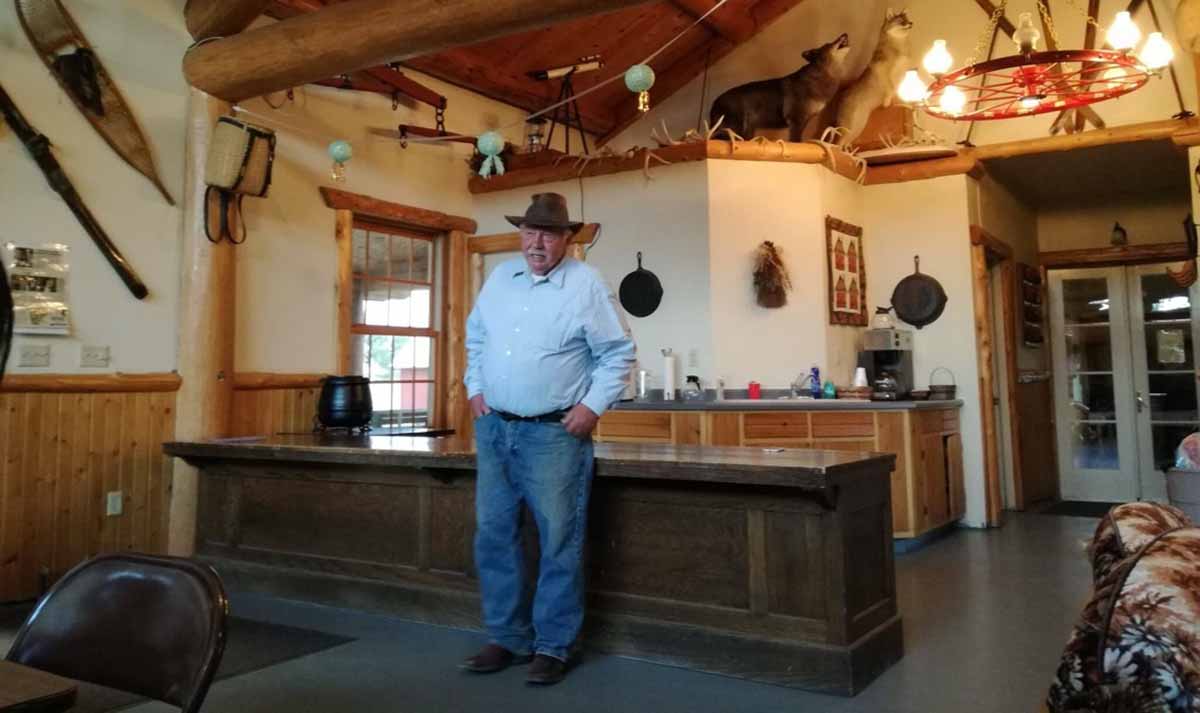
Second – The Conservation Issue
Beside the personal joy of hunting as popular outdoor hobby and the economical role it therefore plays, advocates stress even more the argument of hunting as active conservation work. Especially if the argument is addressed to a non-hunting audience, the notion of the ethical hunter that actively and directly protects nature is claimed to be the most relevant reason for hunting: “For many it is an extension of their ethical relationship with the land and a way they choose to demonstrate their commitment to conservation.” (Koshollek 2018:4)
The idea of protecting or conserving nature through hunting activities mostly refers to the North American Conservation Model: Fees from license purchases as well as taxes on firearms and ammunition are used to fund conservation efforts such as wildlife management, land protection, and habitat restoration (Koshollek 2018:4).
Actually, in 2016 hunting expenditures totaled $26.2 billion, but of this enormous amount only $0.8 billion were spent on licenses, stamps, tags, and permits and another 0.2 billion on plantings (U.S. Fish and Wildlife Service 2016:25). Still, over 70 percent of the total budgets for state wildlife management agencies is provided by hunter-generated revenue in the U.S. (Migliorini 2018:13).
One example for conservation mostly financed by the hunting lobby is the Elk Reintroduction and Habitat Restoration station in the Flambeau River State Forest that we visited. There, we met Laine Stowell, an elk biologist of the Wisconsin Department of Natural Resources. Quite passionately, Laine told us about the successful reintroduction of elks in Wisconsin. However, the financial support of the hunting lobby also takes its toll: After over twenty years of effort to resettle elks from Kentucky and Michigan, slowly increasing their number, tracking and observing every individual with radio collars, the first ten elk bulls were hunted again in 2018.
Third – Critical Voices
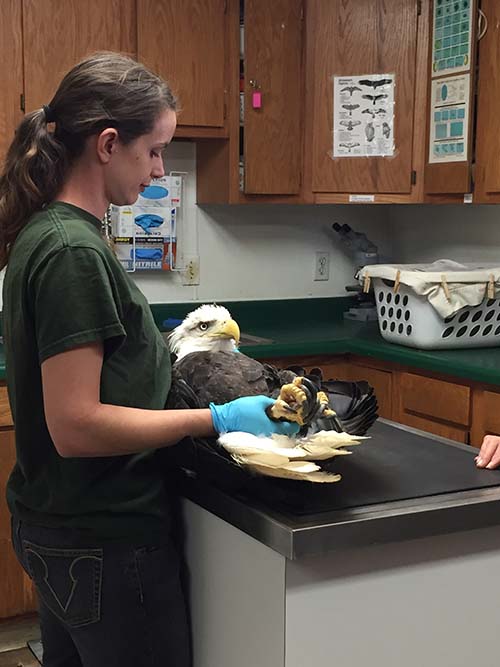
The more places and stakeholders we met during the workshop the more contested became the argument of hunting as providing ecological benefits for all. At the REGI Raptor Education Group, more critical voices arose. Marge Gipson, a charismatic ornithologist, had founded the non-profit organization. She dedicated all her life to the care and rehabilitation of injured or orphaned native bird species as well as to public education on wildlife issues. Many of her zootic patients suffer from lead poisoning after having eaten hunters’ cartridges and shot that was left behind in the landscape.
Marge introduced us to a female bald eagle that also had been poisoned with lead. With amazement we watched the keeper treating the bird so calming, constantly whispering with a low voice, that the eagle allowed her to scale it without being held in place. The bird observed us, vigilantly, but did not resist the procedure nor tried to escape.
While this eagle will be ready for release again, not all birds are lucky enough to be found and brought to Marge in order to receive the chance of recovery through sensitive care. As lead containing hunting munition is a severe threat to wild birds and other animals, the risk of poisoning cases in the region rises with the rise of the hunting activities.
Fourth – Beyond the Animals’ Sphere
In contrast to this, some other parties in the ecosystem benefit from hunting activity because it reduces deer populations. Ecologist Don Waller, a hunter himself, gave us some insights into the effects of overpopulation on temperate forest plant communities. Indeed, an exceeding population of deer in the forests is damaging plant biodiversity. In this regard human hunters are a relevant factor shaping the ecosystem’s condition.
But to add another dimension of complexity, there is yet another actor on the stage. Hunter may be beneficial regulators when it comes to managing the ratio of deer and tree populations. They are less so when it comes to epizootic disease control. The Chronic Wasting Disease (CWD) has become a serious problem in Wisconsin over the last decade. CWD is a transmissible spongiform encephalopathy (TSE). First cases were found in Wisconsin in 2002 through testing of hunted deer.
Even though the disease is not harmful for humans so far, it is a severe threat to elk, reindeer and deer that, if infected, suffer a chronic weight loss leading to death. Especially feeding points and deer farms are critical transmission sites. Many animals that lived on such farms, therefore, had to be killed precautionarily to prevent the spread of the pathogen. Nevertheless, the number of occurrences in Wisconsin increases every year (Wisconsin Department of Natural Resources).
The cooperation with the hunters has shown to be difficult here: In order to get a fundamental set of data to research CWD, broad testing of hunted deer is necessary. But who wants to do all the effort after a successful hunt? The testing of the game often takes long car rides and waiting periods for the results. Therefore, many hunters refrain from testing their harvest – as it is called in the hunting jargon. As long as the disease is not a threat to humans, the mission of wildlife management or the will to support scientific research in order to keep CWD at bay seems to rank second for most hunters.
In this regard, the idea of the hunter as a wildlife manager is restricted to the collected taxes and paid licenses that finance the research instead of involving active participation of the hunting community itself. Reversely, the risk of being infected is three time higher for male bucks. As they are also the preferred prey for hunters, this means that CWD is causing a loss of hunting opportunities, and therefore also a loss in economic prospects for the hunting lobby.
A Complex Constellation of Interests
Marge at REGI was dedicated and interested in non-human lives as intrinsic value, whereas the hunting community’s motivation seems to be more utilitarian. Even though they are committed to population health and intact forests, their conservation motivation seems to be gone as soon as it doesn’t affect them immediately in their interests as humans, sportsmen, outdoor lovers.
Entanglements and perspectives sprawl. There are many more – as travelers we only scratched the surface. Meeting many different experts and stakeholders, we however had the chance to gain a first overview of the complex constellation of interests in Wisconsin. This is not a story only of deer and humans. It is a story also about plant diversity, disease management, small and large-scale businesses, munition ingredients and individual motivations of connecting with the surrounding world.
It is also a story about philosophy and ways of framing human agency, non-human value, and complex relations of responsibilities. Increased or reduced hunting activities therefore have effects on many different levels and at very diverse ends of the scenery.
Taking all this into account, we can try to reconsider the topic of hunting, altering dominant human-centered narratives and being sensible to the spectrum of perspectives on the constant process of making, un-making, contesting and producing the environment, landscape, nature and natural resources.
Literature
- Koshollek, Alanna (ed.). 2018. Why Hunt? A Guide for Nature Lovers, Local Food, and Outdoor Recreation. Aldo Leopold Foundation.
- Migliorini, Robyn. 2018. Why Hunt? In: Koshollek, Alanna (ed.). 2018. Why Hunt? A Guide for Nature Lovers, Local Food, and Outdoor Recreation. Aldo Leopold Foundation.
- U.S. Fish and Wildlife Service and U.S. Census Bureau. 2016 National Survey of Fishing, Hunting, and Wildlife-Associated Recreation. U.S. Department of the Interior, U.S. Fish and Wildlife Service, and U.S. Department of Commerce, U.S. Census Bureau.
- Wisconsin Department of Natural Resources. Chronic Wasting Disease.